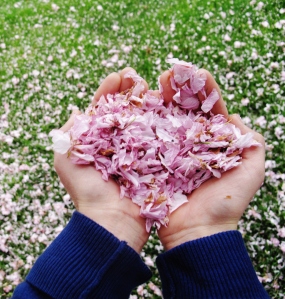Here’s a question for you:
If pink was the designated color for baby boys, and blue the color for baby girls,
would blue be the so called “girly color”?
Like many girls, I went through a phase where I refused to wear pink, especially those obnoxious shades of “bubblegum pink,” and “hot pink.” If you’ve never been to a cosmetic store, you’ll quickly learn about all sorts of shades that you didn’t know existed, ranging from fancy dinner menu items to erotica: “raspberry sherbet,” “wineberry,” and yes, “deep throat.”
Last spring, I was met face-to-face with one of those shades of pink when I won a free pair of running sneakers. The running representative showed me the two options I could choose from: a purple pair or a pink pair. Those were the only colors this new model was being sold in by this particular company. I was disappointed to once again see the “pink or purple only” dilemma that perpetuates the intense marketing of “pink products” chosen to be synonymously associated with girlhood. That’s why I’m grateful for organizations like UK-based Pink Stinks which seeks to “run targeted campaigns aimed at creating positive changes in the products, messages, labeling, categorization and representations of girls.” Their goal is not to do away with the color, but to do away with the damaging messages girls receive from products that are often packaged in pink: pretend make up, dolls that would clearly have an eating disorder (and breast implants) if they were real, and even cleaning supplies like vacuums (who came up with the idea that this is a toy?!).
Faced with the pink or purple shoe choice, I opted for the pink sneakers, snapping out of my initial frustration to be grateful for a free pair of shoes. Privilege, I know, to be able to fuss over colors in the first place. The next thing I picked up that night after the shoes, however, was a red permanent marker. When I went home, I traced every pink outline with the red permanent marker as meticulously as I could, only it didn’t go so well. Now not only did I still have pink on my shoes, but I did such a bad job of coloring that it looked like I regressed back to middle school, when drawing on shoes was considered really cool.
After several runs in my now ridiculous-looking pair of sneakers, I realized the colors didn’t look as dreadful as I once thought they did. I also realized that in the process of eschewing pink, I was feeding into the notion that things designed for girls are inferior to those designed for men. Think back to my earlier example of what would happen if pink was the boy’s color. Let’s expand that one step further: What would happen if men were the designated care providers and women, the breadwinners? Would bread winning be looked down upon, while child rearing, praised?
Is me not wearing pink out of spite contributing to the notion that things associated with women aren’t as good as men’s? Am I continuing to let men set the tone, be it colors to stay away from, or careers to stay away from? Is it more beneficial to change pink from being a “girly” color to shun, to a color that one can wear irrespective of gender without hesitation?
To take this even one step further, we can relate the concept of changing the connotations associated with the color pink to address the ways in which some African American and many LGBTQ communities have reclaimed words that once were considered inferior (dyke, queer, nig*^%). A friend of mine recently shared that her daughter came out as “queer.” The mother told her daughter that, “It’s ok to be gay, but must you call yourself ‘queer?'” The daughter explained to her mother why she chose to self-identify as “queer” and the two of them realized that from generation to generation, words can mean different things. Images can be mean different things. And yes, perhaps even colors like pink can mean different things.
I ponder these concepts of self-identification, reclaiming words and images, and gender as I lay out my clothes for work tomorrow, a task that’s rather innocuous, but teaching me to consider what messages or statements we can send with our clothes, bodies, and words. The decision becomes clear. I decide to wear the shirt with my preferred shade of pink (magenta) and not feel guilty about it. And hey, I may even ditch the pants today for a skirt, too.


















